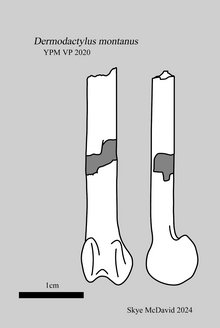Dermodactylus
| Dermodactylus Temporal range: Late Jurassic PreꞒ Ꞓ O S D C P T J K Pg N | |
|---|---|
 | |
| Holotype metacarpal | |
| Scientific classification | |
| Domain: | Eukaryota |
| Kingdom: | Animalia |
| Phylum: | Chordata |
| Order: | †Pterosauria |
| Suborder: | †Pterodactyloidea |
| Family: | †Incertae sedis |
| Genus: | †Dermodactylus Marsh, 1881 |
| Species: | †D. montanus |
| Binomial name | |
| †Dermodactylus montanus (Marsh, 1878) | |
| Synonyms | |
| |
Dermodactylus (meaning "skin finger", from Greek derma and daktylos, in reference to pterosaur wings being skin membranes supported by the ring fingers) was a genus of pterodactyloid (general term for "short-tailed" pterosaur) pterosaur from the Kimmeridgian-Tithonian-age Upper Jurassic Morrison Formation of Wyoming, United States. It is based on a single partial bone, from the hand.
History and classification
Dermodactylus is based on a single distal right fourth metacarpal found by Samuel Wendell Williston at Como Bluff, Wyoming in 1878; this bone is currently housed in the collections of the Yale Peabody Museum of Natural History in New Haven, Connecticut (YPM 2020[1]). This bone constituted at the time the oldest pterosaur remains found, recognized, and described from North America.[2] Othniel Charles Marsh first named it as a species of Pterodactylus:[3] P. montanus, the specific name meaning "from the mountains" in Latin, but soon changed his mind and gave it a new generic name. At the same time he assigned another wing bone, teeth, vertebrae, and a scapulacoracoid to it,[4] but this material is probably too large to belong to the type individual.[5]
Its place within the Pterosauria is uncertain, beyond the Pterodactyloidea.[6] The material it is based on is too meager for further classification (although Carpenter et al.. [2003] note that the shape of the bone's articular end means that it did not belong to an ornithocheirid, a type of short-tailed pterosaur that often had a head crest and/or large teeth),[7] or for adding additional remains to the genus with any certainty, and so it is now regarded as a dubious pterodactyloid.[7][8][9][10] It was not even mentioned in the most recent major popular work on pterosaurs.[11]
Paleobiology
Marsh suggested it had a wingspan of 1.5-1.8 meters (5–6 feet),[4] but this is including the material excluded by Peter Wellnhofer, who estimates the wingspan of the only known individual at 1 meter (3.28 feet).[2] John Foster estimates its weight at 3.3 kilograms (7.3 pounds). It would probably have been a small aerial carnivore.[12]
See also
References
- ^ YPM=Yale University Peabody Museum of Natural History, New Haven, Connecticut.
- ^ a b Wellnhofer, Peter (1996) [1991]. The Illustrated Encyclopedia of Pterosaurs. New York: Barnes and Noble Books. p. 105. ISBN 978-0-7607-0154-6.
- ^ Marsh, Othniel Charles (1878). "New pterodactyl from the Jurassic of the Rocky Mountains". American Journal of Science. Series 3. 16 (93): 233–234. Bibcode:1878AmJS...16..233M. doi:10.2475/ajs.s3-16.93.233.
- ^ a b Marsh, Othniel Charles (1881). "Note on American pterodactyls". American Journal of Science. Series 3. 21 (124): 342–343. Bibcode:1881AmJS...21..342M. doi:10.2475/ajs.s3-21.124.342.
- ^ Wellnhofer, Peter (1978). Pterosauria. Handbuch der Paläoherpetologie, Teil 19. Stuttgart: Gustav Fischer. p. 65. ISBN 978-3-437-30269-5.
- ^ Wellnhofer, Peter (1996) [1991]. The Illustrated Encyclopedia of Pterosaurs. New York: Barnes and Noble Books. p. 107. ISBN 978-0-7607-0154-6.
- ^ a b Carpenter, Kenneth; Unwin, David M.; Cloward, Karen; Miles, Clifford A.; Miles, Clark (2003). "A new scaphognathine pterosaur from the Upper Jurassic Formation of Wyoming, USA". In Buffetaut, Eric; Mazin, Jean- Michel (eds.). Evolution and Palaeobiology of Pterosaurs. Geological Society of London, Special Publications, 217. London: Geological Society of London. pp. 45–54. ISBN 978-1-86239-143-7.
- ^ Harris, Jerald D.; Carpenter, Kenneth (1996). "A large pterodactyloid from the Morrison Formation (Late Jurassic) of Garden Park, Colorado". Neues Jahrbuch für Geologie und Paläontologie - Monatshefte. 8: 473–484.
- ^ Glut, Donald F. (2006). "Dermodactylus". Dinosaurs: The Encyclopedia. 4th Supplement. Jefferson, North Carolina: McFarland & Company, Inc. p. 598. ISBN 978-0-7864-2295-1.
- ^ King, Lorin R.; Foster, John R.; Scheetz, Rodney D. (2006). "New pterosaur specimens from the Morrison Formation and a summary of the Late Jurassic pterosaur record of the Rocky Mountain region". In Foster, John R.; Lucas, Spencer G. (eds.). Paleontology and Geology of the Upper Jurassic Morrison Formation. New Mexico Museum of Natural History and Science Bulletin. Vol. 36. Albuquerque, New Mexico: New Mexico Museum of Natural History and Science. pp. 149–161.
- ^ Unwin, David M. (2006). The Pterosaurs: From Deep Time. New York: Pi Press. pp. 1–347. ISBN 978-0-13-146308-0.
- ^ Foster, John R. (2003). Paleoecological Analysis of the Vertebrate Fauna of the Morrison Formation (Upper Jurassic), Rocky Mountain Region, U.S.A. New Mexico Museum of Natural History and Science Bulletin, 23. Albuquerque, New Mexico: New Mexico Museum of Natural History and Science. p. 37.
Further reading
- James A. Jensen; John H. Ostrom (July 1977). "A Second Jurassic Pterosaur from North America". Journal of Paleontology. 51 (4): 867–870.
- v
- t
- e
| |||||||
|---|---|---|---|---|---|---|---|
| |||||||
|   | |||||||||||||||||||||||||||||||||||||||||
|   | |||||||||||||||||||||||||||||||||||||||||||||||
| 
 | |||||||||||||||||||||||||||||||||||||||||||||||||||||||||||||||||||||||||
| 
 | |||||||||||||||||||||||||||||||||||||||||||||||||||||||||||||||||||||||||||||||||||


















